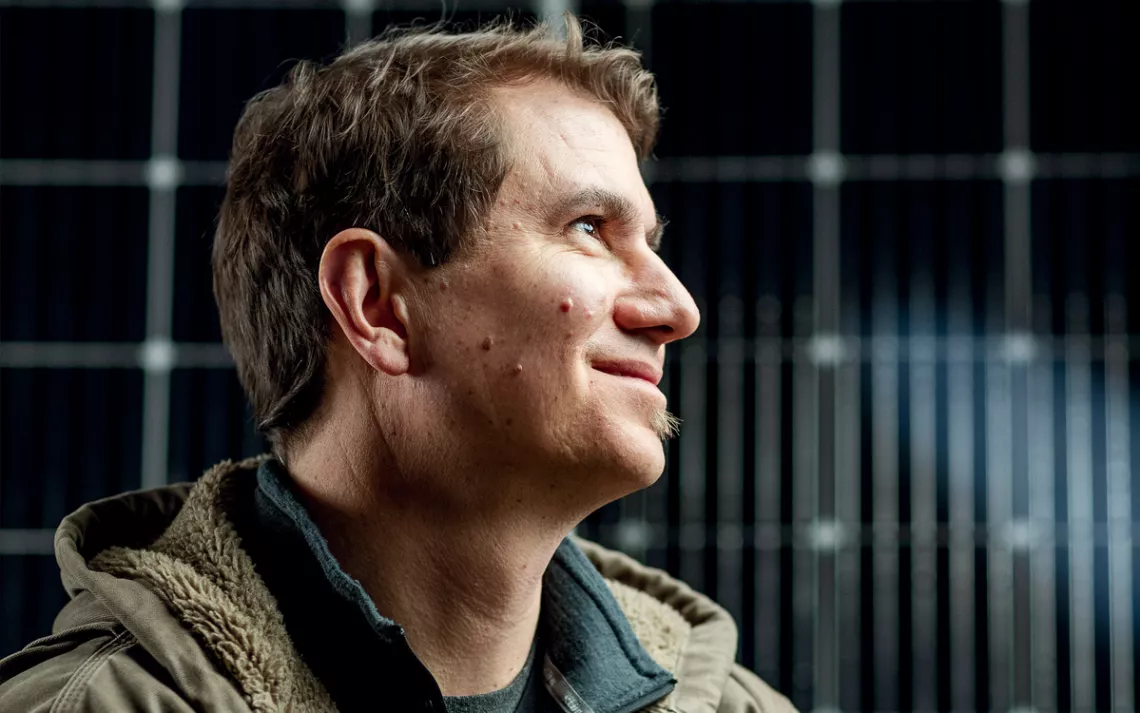Solar Heating Is for Low-Income Folks Too
Lowering heating bills through subsidies for solar instead of gas

Jason Edens, director of the Rural Renewable Energy Alliance | Photo by Sara Rubinstein
Adapted from an interview with Jason Edens by Demetria Lee.
My original plan was to be a teacher. I majored in social studies education at the University of Georgia and then taught English in Japan for three years. I worked in a rural town that is now infamous for the Fukushima nuclear plant, which I biked past on my daily commute.
In 1998, my wife and I returned to the United States and settled in Backus, a small town in Minnesota. As the temperature drops in Minnesota, the heating bill rises, and in 2000 I was a graduate student running out of propane and money. I knew about the federal Low Income Home Energy Assistance Program (LIHEAP) from having been on it intermittently as a kid. I asked if instead of bill assistance I could get a low-interest loan to buy a solar heating unit. They turned me down but told me I could apply for assistance the following year.
The next day, I got a call from a family member in the Twin Cities who told me that some friends were throwing away their solar heating system–they were selling their home, and as a condition of the purchase, the buyers had asked that the "ugly" solar panels be removed from the roof. My wife and I jumped in the truck and drove the three hours to St. Paul, where we pulled the unit out of the dumpster and brought it back to Backus.
I didn't know which end of a hammer to use, but with the help of half a dozen friends, we got the solar unit working. It worked so well that we made it through the winter without energy assistance. That was when everything crystallized. I'd been pursuing a master's degree in environmental policy and planning at Bemidji State, with the vague intention of supporting low-income communities with solar energy. Suddenly I knew exactly how to do that–by incorporating solar into an energy-assistance program.
There was a really generous tax credit for solar during the Carter administration, but Reagan ended it, and the majority of solar-thermal manufacturers went out of business. A lot of solar energy systems were taken off homes, and manufacturers had tons of inventory sitting in storage facilities, so we were able to get truckloads of solar-thermal equipment that we then refurbished.
The nonprofit Rural Renewable Energy Alliance–RREAL–was formed in my garage and stayed there until 2006. An ever-widening group of volunteers and I found low-income households that would make suitable solar recipients. Sometimes we found them through word of mouth; sometimes we went door-to-door asking if residents were interested in a free solar heating unit with free installation. Most of those systems are still up and running.
RREAL began extending its reach beyond northern Minnesota and soon beyond the state, installing hundreds of solar units for low- and moderate-income households. In 2007, we received a patent for our own solar heating device, which we manufactured for more than a decade.
Beneficiaries of the traditional energy-assistance program never see the money that is helping them pay their bills. Those dollars go straight to the utilities as a subsidy for the fossil fuel industry. Solar installations provide households with the same bill assistance and guarantee a reliable amount of energy that won't fluctuate in price.
Unfortunately, LIHEAP's bureaucracy is calcified regarding innovation. We at RREAL are pushing the program to carve out funding for solar assistance. Until then, we're demonstrating the efficacy of our model using grants and philanthropic dollars. In 2017, for instance, we built a solar array on the Leech Lake Band of Ojibwe reservation to supplement its energy-assistance program, and we're currently working with Southeastern Vermont Community Action to do something similar.
At present, solar energy is primarily accessible to more-affluent communities, which only serves to widen the gap between rich and poor. It's not possible to transition to a clean energy economy unless we're intentional about creating pathways for low-income Americans to participate. All the rhetoric about shifting to 100 percent clean energy is hollow unless everyone has access to it.
This article appeared in the March/April 2019 edition with the headline "Solar for Everybody."
 The Magazine of The Sierra Club
The Magazine of The Sierra Club



